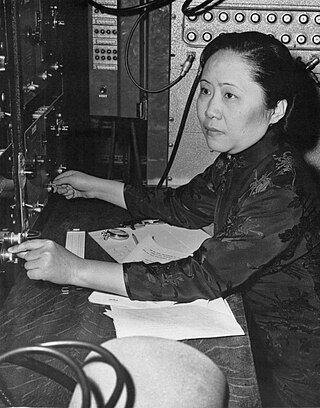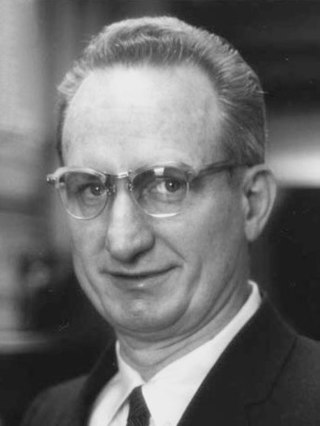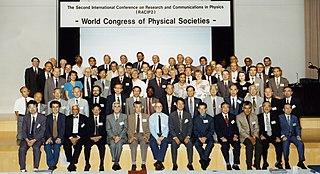Related Research Articles

Yang Chen-Ning or Chen-Ning Yang, also known as C. N. Yang or by the English name Frank Yang, is a Chinese theoretical physicist who made significant contributions to statistical mechanics, integrable systems, gauge theory, and both particle physics and condensed matter physics. He and Tsung-Dao Lee received the 1957 Nobel Prize in Physics for their work on parity non-conservation of weak interaction. The two proposed that the conservation of parity, a physical law observed to hold in all other physical processes, is violated in the so-called weak nuclear reactions, those nuclear processes that result in the emission of beta or alpha particles. Yang is also well known for his collaboration with Robert Mills in developing non-abelian gauge theory, widely known as the Yang–Mills theory.

Chien-Shiung Wu (Chinese: 吳健雄; pinyin: Wú Jiànxióng; Wade–Giles: Wu2 Chien4-hsiung2; May 31, 1912 – February 16, 1997) was a Chinese-American particle and experimental physicist who made significant contributions in the fields of nuclear and particle physics. Wu worked on the Manhattan Project, where she helped develop the process for separating uranium into uranium-235 and uranium-238 isotopes by gaseous diffusion. She is best known for conducting the Wu experiment, which proved that parity is not conserved. This discovery resulted in her colleagues Tsung-Dao Lee and Chen-Ning Yang winning the 1957 Nobel Prize in Physics, while Wu herself was awarded the inaugural Wolf Prize in Physics in 1978. Her expertise in experimental physics evoked comparisons to Marie Curie. Her nicknames include the "First Lady of Physics", the "Chinese Madame Curie" and the "Queen of Nuclear Research".

Emilio Gino Segrè was an Italian and naturalized-American physicist and Nobel laureate, who discovered the elements technetium and astatine, and the antiproton, a subatomic antiparticle, for which he was awarded the Nobel Prize in Physics in 1959 along with Owen Chamberlain.

Leo James Rainwater was an American physicist who shared the Nobel Prize in Physics in 1975 for his part in determining the asymmetrical shapes of certain atomic nuclei.
Nina Byers was a theoretical physicist, research professor and professor of physics emeritus in the department of physics and astronomy, UCLA, and Fellow of Somerville College, Oxford.

Édouard Brézin is a French theoretical physicist. He is professor at Université Paris 6, working at the laboratory for theoretical physics (LPT) of the École Normale Supérieure since 1986.

Helen Rhoda Arnold Quinn is an Australian-born particle physicist and educator who has made major contributions to both fields. Her contributions to theoretical physics include the Peccei–Quinn theory which implies a corresponding symmetry of nature(related to matter-antimatter symmetry and the possible source of the dark matter that pervades the universe) and contributions to the search for a unified theory for the three types of particle interactions. As Chair of the Board on Science Education of the National Academy of Sciences, Quinn led the effort that produced A Framework for K-12 Science Education: Practices, Crosscutting Concepts, and Core Ideas—the basis for the Next Generation Science Standards adopted by many states. Her honours include the Dirac Medal of the International Center for Theoretical Physics, the Oskar Klein Medal from the Royal Swedish Academy of Sciences, appointment as an Honorary Officer of the Order of Australia, the J. J. Sakurai Prize for Theoretical Particle Physics from the American Physical Society, the Karl Taylor Compton Medal for Leadership in Physics from the American Institute of Physics, the 2018 Benjamin Franklin Medal in Physics from the Franklin Institute, and the 2023 Harvey Prize from Technion -- Israel Institute of Technology.

This article discusses women who have made an important contribution to the field of physics.
Gerald Gabrielse is an American physicist. He is the Board of Trustees Professor of Physics and director of the Center for Fundamental Physics at Northwestern University, and Emeritus George Vasmer Leverett Professor of Physics at Harvard University. He is primarily known for his experiments trapping and investigating antimatter, measuring the electron g-factor, and measuring the electron electric dipole moment. He has been described as "a leader in super-precise measurements of fundamental particles and the study of anti-matter."
Francis Goddard Slack was an American physicist. He was a physics teacher, researcher, and administrator in academia who was renowned for placing equal emphasis on teaching and on research.
G. Norris Glasoe was an American nuclear physicist. He was a member of the Columbia University team which was the first in the United States to verify the European discovery of the nuclear fission of uranium via neutron bombardment. During World War II, he worked at the MIT Radiation Laboratory. He was a physicist and administrator at the Brookhaven National Laboratory.

Xiao-Gang Wen is a Chinese-American physicist. He is a Cecil and Ida Green Professor of Physics at the Massachusetts Institute of Technology and Distinguished Visiting Research Chair at the Perimeter Institute for Theoretical Physics. His expertise is in condensed matter theory in strongly correlated electronic systems. In Oct. 2016, he was awarded the Oliver E. Buckley Condensed Matter Prize.

The Wu experiment was a particle and nuclear physics experiment conducted in 1956 by the Chinese American physicist Chien-Shiung Wu in collaboration with the Low Temperature Group of the US National Bureau of Standards. The experiment's purpose was to establish whether or not conservation of parity (P-conservation), which was previously established in the electromagnetic and strong interactions, also applied to weak interactions. If P-conservation were true, a mirrored version of the world (where left is right and right is left) would behave as the mirror image of the current world. If P-conservation were violated, then it would be possible to distinguish between a mirrored version of the world and the mirror image of the current world.
Phyllis S. Freier was an American astrophysicist and a Fellow, American Association for the Advancement of Science and a Fellow, American Physical Society. Freier also served on NASA committees. As a graduate student she presented evidence for the existence of elements heavier than helium in cosmic radiation. Her work was published in Physical Review in 1948 with co-authors Edward J. Lofgren, Edward P. Ney, and Frank Oppenheimer.
Gail G. Hanson, born 22 February 1947 in Dayton, Ohio is an American experimental particle physicist.

Judy Franz is an American physicist, educator and the former executive officer of the American Physical Society.

Ágnes Mócsy is a Professor of Physics at the Pratt Institute who works on theoretical nuclear physics. She is also a filmmaker, science communicator and a Fellow of the American Physical Society.

Maria Cristina Marchetti is an Italian-born, American theoretical physicist specializing in statistical physics and condensed matter physics. In 2019, she received the Leo P. Kadanoff Prize of the American Physical Society. She held the William R. Kenan, Jr. Distinguished Professorship of Physics at Syracuse University, where she was the director of the Soft and Living Matter program, and chaired the department 2007–2010. She is currently Professor of Physics at the University of California, Santa Barbara.

Elvira Moya de Guerra is a Spanish theoretical nuclear physicist who became the first female full professor of physics in Spain. She is a professor emerita of physics at the Complutense University of Madrid. Her research topics have included double beta decay.
William Joseph Marciano is an American theoretical physicist, specializing in elementary particle physics.
References
- 1 2 "CWP at physics.UCLA.edu // Noemie Benczer Koller". cwp.library.ucla.edu.
- 1 2 3 4 5 6 7 Oakes, Elizabeth H. (2007). "Koller, Noemie Benczer". Encyclopedia of world scientists. Vol. 1 (Rev. ed.). New York: Facts on File. pp. 410–411. ISBN 9780816061587. OCLC 83610106.
- 1 2 3 4 5 6 7 Koller, Noemie Benczer (2013). "Noemie Benczer Koller". Blazing the trail : essays by leading women in science. Ideal, Emma, Meharchand, Rhiannon, ed. [United States]. pp. 158–165. ISBN 9781482709438. OCLC 856903108.
{{cite book}}: CS1 maint: location missing publisher (link) - 1 2 3 4 Koller, Noemie. "Koller, Noemie | Rutgers Women in Science". wisem.rutgers.edu. Retrieved 2018-05-02.
- ↑ Koller, Noemie, Benczer. "Personal Memories of Chien-Shiung Wu" . Retrieved 2018-05-04.
{{cite web}}: CS1 maint: multiple names: authors list (link) - ↑ Koller, Noemie (2009). "Chien-Shiung Wu 1912-1997" (PDF). Washington, D.C.: National Academy of Sciences. Retrieved 2018-05-04.
- 1 2 3 Nemeh, Katherine H., ed. (2008). "Koller, Noemie". American Men & Women of Science: A Biographical Directory of Today's Leaders in Physical, Biological, and Related Sciences. Vol. 4 (25th ed.). Detroit: Gale. ISBN 9781414437491.
- 1 2 Leath, Paul. "Noemie Koller Scholarship". www.physics.rutgers.edu. Retrieved 2018-05-02.
- ↑ Song, Cheng-jyi; Trooster, Jan; Benczer-Koller, N. (1974-05-01). "Measurement of 2s and 3s electron-spin densities in iron metal and Fe2O3". Physical Review B. 9 (9). American Physical Society (APS): 3854–3863. Bibcode:1974PhRvB...9.3854S. doi:10.1103/physrevb.9.3854. ISSN 0556-2805.
- ↑ Yang, T.; Krishnan, A.; Benczer-Koller, N.; Bayreuther, G. (1982-05-03). "Surface Magnetic Hyperfine Interactions in Fe2O3 Determined by Energy-Resolved Conversion-Electron Mössbauer Spectroscopy". Physical Review Letters. 48 (18). American Physical Society (APS): 1292–1295. Bibcode:1982PhRvL..48.1292Y. doi:10.1103/physrevlett.48.1292. ISSN 0031-9007.
- ↑ Beardsworth, E.; Hensler, R.; Tape, J. W.; Benczer-Koller, N.; Darcey, W.; MacDonald, Jack R. (1973-07-01). "Double Gamma Decay in 40Ca". Physical Review C. 8 (1). American Physical Society (APS): 216–229. Bibcode:1973PhRvC...8..216B. doi:10.1103/physrevc.8.216. ISSN 0556-2813.
- ↑ MacDonald, Jack R.; Benczer-Koller, N.; Tape, J.; Guthman, Lewis; Goode, Philip (1969-09-15). "Measurement of the Mean Life of the 4.49-MeV (5−) State of 40Ca. Effects of Deformed Components on the Lifetimes of the Odd-Parity States". Physical Review Letters. 23 (11). American Physical Society (APS): 594–597. Bibcode:1969PhRvL..23..594M. doi:10.1103/physrevlett.23.594. ISSN 0031-9007.
- ↑ Wolf, A.; Warner, D.D.; Benczer-Koller, N. (1985). "Effective g factors and proton-boson numbers in the vicinity of proton subshell closures". Physics Letters B. 158 (1). Elsevier BV: 7–10. Bibcode:1985PhLB..158....7W. doi:10.1016/0370-2693(85)90727-0. ISSN 0370-2693.
- ↑ "APS Fellow Archive". www.aps.org. Retrieved 2018-05-07.
- ↑ Martel, Michelle. "The Daniel Gorenstein Memorial Award". www.math.rutgers.edu. Retrieved 2018-05-07.
- ↑ "Distinguished Service Award". www.aps.org. Retrieved 2018-05-07.
- ↑ Winick, Herman (March 2011). "Noemie Koller Receives APS Nicholson Medal for Human Outreach". www.aps.org. Retrieved 2018-05-07.